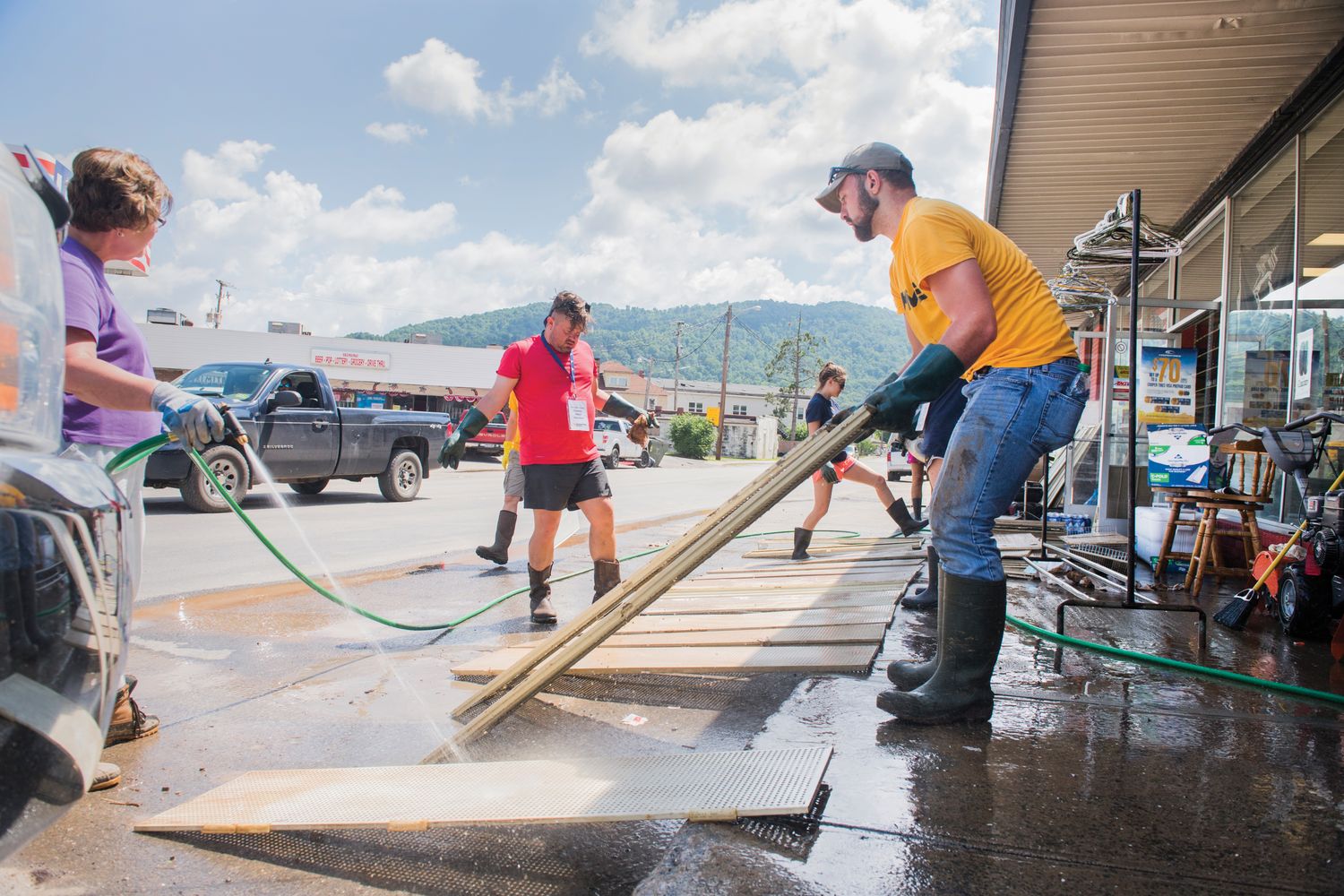“When I saw on the news that Clendenin was totally under water, and I had just driven through there not six hours before, that’s when I realized this was major. This was something we had never seen before,” said Anita Stephenson, principal at Clay County Middle School.
A few miles away, Janet Osborne watched the tiny creek beside her home become a raging monster. “The water came so fast — the force of it hit the basement door, took it out and went through several 40-foot walls,” she said. “The water came up to the third step from the top of the basement stairs before it started to go down.”
Some 65 miles southeast, in Rainelle, business owner Paul Raines sent his employees home, but he wasn’t worried. His Western Auto store has been there for decades and he’d figured he’d seen it all. Until someone pulled up outside the store and told him two trailers down the road had washed away.
“Then I saw the water coming,” he said.
Around the country, news media were calling it a 1,000-year flood, an event so rare — with some 10 inches of rain failing in 12 hours in many places — that it is now considered the seventh deadliest flood in the state’s history. The night of June 23, thousands of West Virginians clung to floating furniture, slept on rooftops and in their cars on higher ground.
In rural towns across the state people began picking up the pieces of their lives. And behind them rose a wave of much-needed support. Busloads of perfect strangers from across the state and the country arrived to help while community members like Kathi Linkinoggor, whose sons’ homes also sustained damage, found the strength to help their neighbors. In Linkinoggor’s case, she set up and directs a flood relief center out of her church, one that has been feeding and handing out supplies to local families since just days after the flood.

From June 24 to July 6, the center had more than 350 volunteers who have served an estimated 3,000 hours. And their efforts also attracted community members to participate — businesses like Parc’s Trucking and ilease & Rentals, who donated tractor-trailers and volunteered their time to make deliveries, and Kroger, who allowed WVU to use its parking lots to stage donation collection and sorting.
The WVU Health Sciences Center mobilized immediately after the flood, providing medical teams — some 77 volunteer nurses and physicians — to staff clinics, gathering 300 tetanus vaccines for victims, assisting the National Guard on house health checks and much more. Meanwhile, WVU Health Sciences Center Charleston sent 18 physicians to the Clendenin Clinic, providing 2,700 patient encounters over 11 days following the flood.
Other departments and student organizations mustered their expertise and helped fill the gaps. WVU’s chapters of the American Society of Civil Engineers and Engineers Without Borders traveled to Bomont to help repair damaged homes, from installing electrical wires to framing and putting up drywall and insulation.
The Land Use and Sustainable Development Law Clinic at the WVU College of Law began working with flood-devastated communities pro bono to review and implement communities’ plans for redevelopment, work that helped Richwood qualify for a $650,000 flood-relief grant.

Outside the immediate WVU community, Mountaineer alumni and friends, led by alumnus Ken Kendrick, gave $500,000. And Kendrick matched them, helping to raise $1 million for flood relief. Those funds will go toward current WVU students who experienced a financial hardship because of the flooding as well as the WVU Extension Service’s efforts to identify and assist residents with home repairs and personal property losses.
For Raines, one group in particular he’ll never forget — WVU students, among them alternate Mountaineer Mascot Savannah Lusk — showed up on his doorstep less than a week after the flood and helped him get back on his feet.
“These kids worked their tails off. It was nasty stuff, and the more you cleared out, the more you found,” he said. “But they hung in there and did anything and everything. And groups of them went all over town doing the same thing.”
But there is still much more to be done. Pounds of mud still sit in basements, deadly mold is creeping in and windows, doors and walls have buckled and must be replaced. Building materials, appliances, skilled contractors and sheer manpower are needed. Linkinoggor says even her community’s basic infrastructure is in need of repair.
“FEMA told us around 150 bridges washed out in the storm — many of them private,” she said. “I fear people are spending their life savings in a month or so just to get back up and running.”
Although the waters have receded, the fight to save many of these towns is far from over. Clay County WVU Extension Agent Mike Shamblin says the next phase of rebuilding will be the longest and hardest road to travel.
“The help has been amazing, the food and water and medical supplies,” he said, “But we need to rebuild now, and I think we are still going to see incredible needs here for years to come.”
A few miles away, Janet Osborne watched the tiny creek beside her home become a raging monster. “The water came so fast — the force of it hit the basement door, took it out and went through several 40-foot walls,” she said. “The water came up to the third step from the top of the basement stairs before it started to go down.”
Some 65 miles southeast, in Rainelle, business owner Paul Raines sent his employees home, but he wasn’t worried. His Western Auto store has been there for decades and he’d figured he’d seen it all. Until someone pulled up outside the store and told him two trailers down the road had washed away.
“Then I saw the water coming,” he said.
Around the country, news media were calling it a 1,000-year flood, an event so rare — with some 10 inches of rain failing in 12 hours in many places — that it is now considered the seventh deadliest flood in the state’s history. The night of June 23, thousands of West Virginians clung to floating furniture, slept on rooftops and in their cars on higher ground.
In rural towns across the state people began picking up the pieces of their lives. And behind them rose a wave of much-needed support. Busloads of perfect strangers from across the state and the country arrived to help while community members like Kathi Linkinoggor, whose sons’ homes also sustained damage, found the strength to help their neighbors. In Linkinoggor’s case, she set up and directs a flood relief center out of her church, one that has been feeding and handing out supplies to local families since just days after the flood.
Volunteers from WVU amassed flood relief donations collected at centers like this one at the Coliseum on June 25 (Photo by Jennifer Shephard).
Hours away, the West Virginia University community quickly surged into action. Just hours after the news came, the Center for Service and Learning and WVU Student Government Association as well as other student leaders came together to brainstorm. They organized a massive collection that sent tractor-trailer loads of supplies to affected communities and helped coordinate and support students, student athletes, staff and alumni groups who wanted to help.From June 24 to July 6, the center had more than 350 volunteers who have served an estimated 3,000 hours. And their efforts also attracted community members to participate — businesses like Parc’s Trucking and ilease & Rentals, who donated tractor-trailers and volunteered their time to make deliveries, and Kroger, who allowed WVU to use its parking lots to stage donation collection and sorting.
The WVU Health Sciences Center mobilized immediately after the flood, providing medical teams — some 77 volunteer nurses and physicians — to staff clinics, gathering 300 tetanus vaccines for victims, assisting the National Guard on house health checks and much more. Meanwhile, WVU Health Sciences Center Charleston sent 18 physicians to the Clendenin Clinic, providing 2,700 patient encounters over 11 days following the flood.
Other departments and student organizations mustered their expertise and helped fill the gaps. WVU’s chapters of the American Society of Civil Engineers and Engineers Without Borders traveled to Bomont to help repair damaged homes, from installing electrical wires to framing and putting up drywall and insulation.
The Land Use and Sustainable Development Law Clinic at the WVU College of Law began working with flood-devastated communities pro bono to review and implement communities’ plans for redevelopment, work that helped Richwood qualify for a $650,000 flood-relief grant.
WVU pharmacy student and singer Rebecca Berhanu released her debut single, "West Virginia Strong," in September, now available on iTunes. The royalties will benefit flood victims (Photo by M.G. Ellis).
And some students developed their own creative ways of helping. Pharmacy student Rebecca Berhanu, an accomplished singer, was inspired by the flood relief efforts and wanted to contribute. She wrote a song and created a single called “West Virginia Strong” with Mon Hills Records, WVU’s student-run record label. All the proceeds from sales of her single will go to WVU’s Dollars for Disaster relief fund.Outside the immediate WVU community, Mountaineer alumni and friends, led by alumnus Ken Kendrick, gave $500,000. And Kendrick matched them, helping to raise $1 million for flood relief. Those funds will go toward current WVU students who experienced a financial hardship because of the flooding as well as the WVU Extension Service’s efforts to identify and assist residents with home repairs and personal property losses.
For Raines, one group in particular he’ll never forget — WVU students, among them alternate Mountaineer Mascot Savannah Lusk — showed up on his doorstep less than a week after the flood and helped him get back on his feet.
“These kids worked their tails off. It was nasty stuff, and the more you cleared out, the more you found,” he said. “But they hung in there and did anything and everything. And groups of them went all over town doing the same thing.”

In Rainelle, Paul Raines lost thousands of dollars in inventory from his store, but the WVU community arrived on the scene to help him get back on his feet (Photo by Brian Persinger).
But there is still much more to be done. Pounds of mud still sit in basements, deadly mold is creeping in and windows, doors and walls have buckled and must be replaced. Building materials, appliances, skilled contractors and sheer manpower are needed. Linkinoggor says even her community’s basic infrastructure is in need of repair. “FEMA told us around 150 bridges washed out in the storm — many of them private,” she said. “I fear people are spending their life savings in a month or so just to get back up and running.”
Although the waters have receded, the fight to save many of these towns is far from over. Clay County WVU Extension Agent Mike Shamblin says the next phase of rebuilding will be the longest and hardest road to travel.
“The help has been amazing, the food and water and medical supplies,” he said, “But we need to rebuild now, and I think we are still going to see incredible needs here for years to come.”
